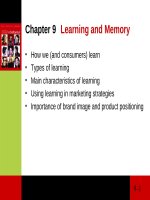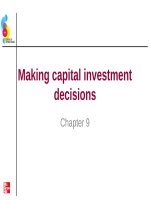Lecture Organizational behavior - Chap 9: Introducing organizational behavior
Bạn đang xem bản rút gọn của tài liệu. Xem và tải ngay bản đầy đủ của tài liệu tại đây (5.54 MB, 36 trang )
Chapter 9
Decision Making and
Creativity
You have to make good choices
Chapter 9 Study Questions
What is involved in the decision-making process?
What are the alternative decision-making
models?
What are key decision-making traps and issues?
What can be done to stimulate creativity in
decision making?
Copyright © 2014 John Wiley & Sons,
9-2
What is involved in the decisionmaking process?
Decisionmaking
• The process of choosing a course of action for
dealing with a problem or opportunity.
Copyright © 2014 John Wiley & Sons,
9-3
What is involved in the decisionmaking process?
Steps in Decision Making
• Recognize and define the problem
• Identify and analyze alternative courses of
action.
• Choose a preferred course of action
• Implement the preferred course of action
Lack-of-participation error – occurs when
important people are excluded from the
decision-making process.
• Evaluate the results and follow-up as
necessary.
Copyright © 2014 John Wiley & Sons,
13-4
What is involved in the
decision-making
process?
Copyright © 2014 John Wiley & Sons, Inc.
9-5
What is involved in the decisionmaking process?
Ethics
• The philosophical study of morality or standards
regarding good character and conduct.
Moral problem
• One that poses major ethical consequences for
the decision maker or for others.
Copyright © 2014 John Wiley & Sons,
9-6
What is involved in the decisionmaking process?
Moral dilemma
• Decision maker faces two or
more ethically uncomfortable
alternatives.
• Either alternative is potentially
beneficial and harmful.
Copyright © 2014 John Wiley & Sons,
9-7
Figure 9.1 The decision-making
process and ethical reasoning
model
Copyright © 2014 John Wiley & Sons, Inc.
9-8
What is involved in the decisionmaking process?
Ethical double checks
• Criteria
Utility – all stakeholders satisfied?
Rights – are all rights and duties respected?
Justice – is it consistent with cannons of justice?
Caring – is it consistent with responsibility to care?
Copyright © 2014 John Wiley & Sons,
9-9
What is involved in the decisionmaking process?
Ethical Double Checks
• Spotlight Questions
How would I feel if my family found out about this
decision?
How would I feel if the decision was published?
What would the person you know or know of who has
the strongest character do in this situation?
Copyright © 2014 John Wiley & Sons,
9-10
What is involved in the decisionmaking process?
Programmed decisions
• Made as standardized responses to recurring
situations and routine problems.
Nonprogrammed decisions
• Specifically crafted or tailored to fit a unique
situation.
Crisis decision – unexpected problem threatens
major harm and disaster if not resolved quickly
and appropriately.
Copyright © 2014 John Wiley & Sons,
9-11
What is involved in the decisionmaking process?
Decisions are made in the context of three general
environments.
• Certainty
• Risk
• Uncertainty
Copyright © 2014 John Wiley & Sons,
9-12
What is involved in the decisionmaking process?
A decision environment is certain
• When information is sufficient to predict
the results of each alternative in advance
of implementation.
Copyright © 2014 John Wiley & Sons,
9-13
What is involved in the decisionmaking process?
A decision environment is risky
• When decision makers lack complete
certainty regarding the outcomes of various
courses of action, but they are aware of the
probabilities associated with their
occurrence.
Copyright © 2014 John Wiley & Sons,
9-14
What is involved in the decisionmaking process?
A decision environment is uncertain
• When managers have so little information on hand that
they cannot even assign probabilities to various
alternatives and their possible outcomes.
Copyright © 2014 John Wiley & Sons,
9-15
Figure 9.2 Combinations of
decision environments and types
of decisions
Copyright © 2010 John Wiley &
1-16
What is involved in the decisionmaking process?
Risk Management
• Involves anticipating risks and factoring
them into decision making.
Copyright © 2014 John Wiley & Sons,
9-17
Figure 9.3 Decision making viewed
from the classical and behavioral
perspectives
Copyright © 2014 John Wiley & Sons, Inc.
9-18
What are the alternative
decision-making models?
Classical decision model assumes a manager:
• Acts rationally and in a fully informed manner.
• Faces a clearly defined problem.
• Knows all possible action alternatives and their
consequences.
• Chooses the optimum solution that give the
absolute best solution to the problem.
Copyright © 2014 John Wiley & Sons,
9-19
What are the alternative
decision-making models?
Behavior decision model
• Suggests that people act only in terms of their
perceptions, which are frequently imperfect.
Satisficing decisions
• Decision makers choose the first alternative
that appears to give an acceptable or
satisfactory resolution of the problem.
Copyright © 2014 John Wiley & Sons,
9-20
What are the alternative decisionmaking models?
Teams engage in two cognitive processes:
Systematic
• Problem approach utilizing a rational, analytic
thinking.
Intuitive
• Problem approach that is flexible and
spontaneous.
• A key element of decision-making under
risky and uncertainty conditions.
Copyright © 2014 John Wiley & Sons,
9-21
What are key decision-making
traps and issues?
Judgmental heuristics
• Simplifying strategies or shortcuts used to make
decisions.
• Make it easier to deal with uncertainty and
limited information common to problem
situations.
Copyright © 2014 John Wiley & Sons,
9-22
What are key decision making
traps and issues?
Availability heuristic
• Involves assessing a current event based on
past occurrences that are easily available in
one’s memory.
Representativeness heuristic
• Involves assessing the likelihood that an
event will occur based on its similarity to
one’s stereotypes of similar occurrences
Copyright © 2014 John Wiley & Sons,
9-23
What are key decision making
traps and issues?
Anchoring and adjustment heuristic
• Involves assessing an event by taking
an initial value from historical
precedent or an outside source and
then incrementally adjusting this value
to make a current assessment.
Copyright © 2014 John Wiley & Sons,
9-24
What are key decision making
traps and issues?
Decision Bias
• Confirmation error – only seeking cues in a situation that
support a preexisting opinion.
• Hindsight error– overestimate the degree to which an
event that has already taken place could have been
predicted .
• Framing error - tendency to evaluate and resolve a
problem in the context in which it is perceived – either
positive or negative.
Copyright © 2014 John Wiley & Sons,
9-25









